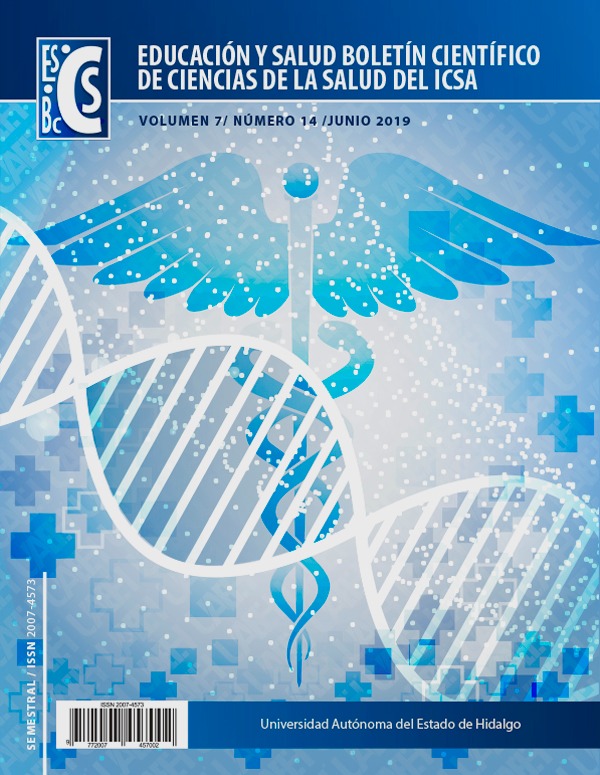Proximal Chemical Analysis of Hive Products from an Apiary of Tulancingo, Hidalgo
Abstract
Since ancient times, the products of the beehive have been used as a medicinal remedy due to its nutritional and functional value established in various investigation through identification of compounds with important biological properties (Cornara, Biagi, Xiao, & Burlando, 2017; Tenore, Ritieni, Campiglia, & Novellino, 2012). The proximal chemical analysis (AQP), is an indispensable analytical method, carried out to determine the quality of a food product and includes the percentage of humidity, ash, fat (ethereal extract), protein and carbohydrates (Greenfield & Southgate, 2003). The purpose of the present research was to evaluate the AQP of samples of honey, royal jelly, pollen and propolis. The samples were obtained from an apiary in Tulancingo, Hidalgo. The AQP was performed according to the procedures established by AOAC 2016, AOAC 2005, NMX-F-608-2011, NMX-F-089-S-1978. The results obtained showed that the products of the beehive analyzed are similar to previous studies and also comply with the guidelines established by Mexican and other countries regulations. Beehive products from the municipality of Tulancingo Hidalgo, are considered a good source of nutrients and energy, based on quality guidelines in international and national standards, in terms of composition and nutritional value.
Downloads
References
Adetuyi, F. O., Ibrahim, T. A., & Ogundahunsi, G. A. (2009). Total phenol , tocopherol and antibacterial quality of honey Apis mellifera sold in Owo community , Ondo State , Nigeria, 8(7), 1305–1309.
Almeida-Muradian, L. B., Pamplona, L. C., Coimbra, S., & Barth, O. M. (2005). Chemical composition and botanical evaluation of dried bee pollen pellets. Journal of Food Composition and Analysis, 18(1), 105–111.
AOAC. (2005). Official Methods of Analysis of AOAC International. (18th Ed). Gaithersburg, E.U.U.
AOAC. (2016). Official Methods of Analysis of AOAC International. (20 Ed.). Gaithersburg, E.U.U.
Baroni, M., Nores, M., Díaz, M., Chiabrando, G., Fassano, J., Costa, C., & Wunderlin, D. (2006). Determination of volatile organic compound patterns characteristics of five unifloral honeys by solid- phase microextraction—Gas chromatography-mass spectrometry coupled to chemimetrics. J. Agric. Food Chem., 54, 7235–7241.
Bello, J. (2000). Ciencia Bromatológica. Principios generales de los alimentos. España, Madrid: Ediciones Diaz de Santos.
Bertoncelj, J., Pucihar, T., & Borov, A. K. (2018). Carbohydrate composition of Slovenian bee pollens. International Journal of Food and Technology, 53(8), 1–9.
Bogdanov, S., Jurendic, T., Sieber, R., & Gallmann, P. (2013). Honey for nutrition and health: A review. Journal of the American College of Nutrition, 27(6), 677–689.
Codex Alimentarius Commission. (2001). (2001a) Codex Standard for Honey, FAO, Rome. Alinorm 1: 19-26. Allinorm 1, 19–26.
Cornara, L., Biagi, M., Xiao, J., & Burlando, B. (2017). Therapeutic properties of bioactive compounds from different honeybee products. Frontiers in Pharmacology, 8, 1–20.
El Sohaimy, S. A., Masry, S. H. D., & Shehata, M. G. (2015). Physicochemical characteristics of honey from different origins. Annals of Agricultural Sciences, 60(2), 279–287.
Feas, X., Vazquez-Tato, M. P., Estevinho, L., Seijas, J. A., & Iglesias, A. (2012). Organic bee pollen: Botanical origin, nutritional value, bioactive compounds, antioxidant activity and microbiological quality. Molecules, 17(7).
Fuenmayor B, C., Zuluaga D, C., Díaz M, C., Quicazán de C, M., Cosio, M., & Mannino, S. (2014). Evaluation of the physicochemical and functional properties of Colombian bee pollen. Rev.MVZ Córdoba, 19(1), 4003–4014.
Huang, S., Zhang, C.-P., Wang, K., Li, G., & Hu, F.-L. (2014). Recent advances in the chemical composition of propolis. Molecules, 19, 19610–19632.
Isidorov, V. A., Czyzewska, U., Isidorova, A. G., & Bakier, S. (2009). Gas chromatographic and mass spectrometric characterization of the organic acids extracted from some preparations containing lyophilized royal jelly. Journal of Chromatography B, 877(29), 3776–3780.
Kaur, R., Kumar, N. R., & Harjai, K. (2013). Phytochemical analysis of different extracts of bee pollen. International Journal of Pharmaceutical and Biological Research, 4(3), 65–68.
Küçük, M., Kolayli, S., Karaoǧlu, Ş., Ulusoy, E., Baltaci, C., & Candan, F. (2007). Biological activities and chemical composition of three honeys of different types from Anatolia. Food Chemistry, 100(2), 526–534.
Manyi-Loh, C., Clarke, A., & Ndip, R. (2011). An overview of honey: Therapeutic properties and contribution in nutrition and human health. African Journal of Microbiology Research, 5(9), 844–852.
Marchini, L., Moreti, A. C. de C. C., Otsuk, I., & Sodré, G. (2007). Physicochemical composition of Apis mellifera honey samples from sao Paulo state, Brazil. Química Nova, 30(7), 1653–1657.
Nicolson, S. W. (2011). Bee Food: The chemistry and nutritional value of nectar, pollen and mixtures of the two. African Zoology, 46(2), 197–204.
NMX-F-036-1997. (1997). NMX F-036-1997.Alimentos-Miel ,especificaciones, métodos de prueba. Norma Oficial Mexicana.
NMX-F-089-S-1978. (1978). NMX-F-089-S-1978. DETERMINACIÓN DE EXTRACTO ETÉREO (MÉTODO SOXHLET) EN ALIMENTOS. Norma Oficial Mexicana, 1–3.
NMX-F-608-2011. (2011). NMX-F-608-2011. Alimentos. Determinación De Proteínas. Norma Oficial Mexicana, 3–6.
Omafuvbe, B. O., & Akanbi, O. O. (2009). Microbiological and physico-chemical properties of some commercial Nigerian honey. African Journal Of Microbiology Research, 3(12), 891–896.
Oryan, A., Alemzadeh, E., & Moshiri, A. (2016). Biological properties and therapeutic activities of honey in wound healing: A narrative review and meta-analysis. Journal of Tissue Viability, 25(2), 98–118.
Sanatini, A. G., Marcazzan, G. L., Caboni, M. F., Bogdanov, S., & De Almaeida-Muradian, L. B. (2009). Quality and standardisation of royal jelly. Journal of ApiProduct and ApiMedical Science, 1(1), 1–6.
Srisuparbh, D., Klinbunga, S., Wongsiri, S., & Sittipraneed, S. (2003). Isolation and characterization of major royal jelly cDNAs and proteins of the honey bee (Apis cerana). Journal of Biochemistry and Molecular Biology, 36(6), 572–579.
Sun, C., Wu, Z., Wang, Z., & Zhang, H. (2015). Effect of ethanol/water solvents on phenolic profiles and antioxidant properties of Beijing propolis extracts. Evidence-Based Complementary and Alternative Medicine, 2015, 1–9.
Taylor, P., Bogdanov, S., Lüllmann, C., Martin, P., Ohe, W. Von Der, Russmann, H., … Vit, P. (1999). Bee World Honey quality and international regulatory standards : review by the International Honey Commission. Bee World, 80(261–69).
UNAM. (2008). Fundamentos y Técnicas de Análisis De Alimentos. México: Universidad Autónoma De México.












